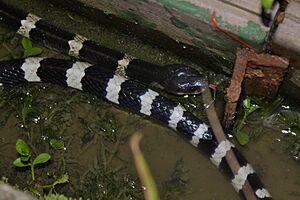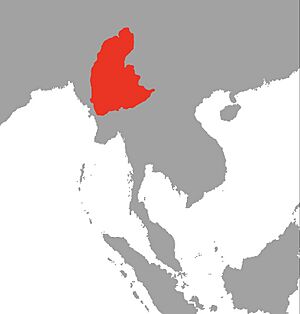Bungarus magnimaculatus facts for kids
Quick facts for kids Bungarus magnimaculatus |
|
|---|---|
 |
|
| Conservation status | |
| Scientific classification | |
| Genus: |
Bungarus
|
| Species: |
magnimaculatus
|
 |
|
| Synonyms | |
|
Bungarus caeruleus var. magnimaculata Wall & Evans, 1901 |
|
The Bungarus magnimaculatus, often called the Burmese krait, is a type of snake. People also know it as the spotted krait or the splendid krait. This snake is venomous, meaning it can inject poison. It belongs to the same family as cobras. You can only find this special snake in the country of Myanmar.
Contents
What Does the Burmese Krait Look Like?
The Burmese krait is a medium-sized snake. It usually grows to about 1.1 m (3 ft 7 in) long. Some bigger ones can reach up to 1.45 m (4 ft 9 in). Like most kraits, it has a thin body. Its tail is short and gets thinner towards the end. The tail is usually around 150 mm (5.9 in) long.
This snake has a flat head. Its head is a little bit wider than its neck. The eyes are small to medium in size. They have black, round pupils. The scales on its back are smooth and shiny. The scales along its spine are larger and shaped like hexagons. The body of this snake is shaped like a triangle if you cut it in half.
The back of the Burmese krait has 11 to 14 wide, white stripes. These stripes are as wide as the black spaces between them. Sometimes, the white scales have black spots in the middle. The belly of this snake is completely white.
Where Does the Burmese Krait Live?
The Burmese krait lives only in Myanmar. This means it is endemic to that country. You can find it in areas like Mandalay, Sagaing, and Magway. These are all parts of Myanmar.
Scientists think it might also live in nearby parts of China, Thailand, Laos, Bangladesh, or India. However, no one has seen it there yet.
The first Burmese krait found was in Meiktila, Myanmar. This area has dry forests that change with the seasons. So, this snake probably lives in the dry parts of central Myanmar. It likes dry tropical forests in low areas. People have also found these snakes near farms and villages. They can live from sea level up to 1,000 m (3,300 ft) high.
How Does the Burmese Krait Behave?
The Burmese krait is a land snake. It is nocturnal, which means it is active at night. During the day, it rests or hides.
This snake is usually calm and shy. If it feels bothered or threatened, it often curls up loosely. It will also hide its head under its body. It does not like to bite unless someone keeps bothering it a lot.
What Does the Burmese Krait Eat?
The Burmese krait mostly eats other snakes. But it also sometimes eats other small animals. These can include small mammals like rats and mice. It might also eat lizards, frogs, and even fish.
Is the Burmese Krait Venomous?
Yes, the Burmese krait is venomous. Not much is known about its venom. But like other krait snakes, its venom is very strong. It contains special poisons called neurotoxins. These toxins can affect the nervous system.
There is no special medicine (called an antivenom) for bites from this snake. However, bites on humans are extremely rare. There are no clear records of people dying from bites by this snake.


